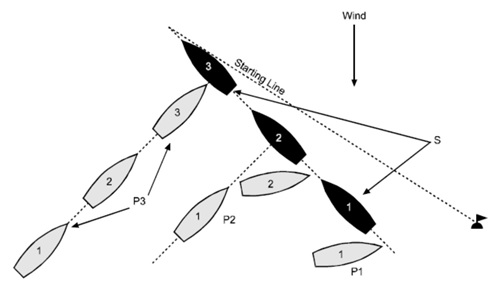



CASE 87
Definitions, Keep Clear
Rule 10, On Opposite Tacks
Rule 14, Avoiding Contact
A right-of-way boat need not act to avoid contact until it is
clear that the other boat is not keeping clear.

Facts
The angle of the starting line made it only just possible for a close-hauled
boat on starboard tack to cross the line, and most boats approached on port
tack. However, S approached on starboard tack from the right-hand end,
continually hailing ‘Starboard’ to port-tack boats as they approached.
P1 and P2 bore off below S. P3, however, made no attempt to avoid S and
struck her amidships at right angles, causing considerable damage. The
protest committee disqualified both boats, P3 under rule 10 and S under rule
14. S appealed.
Decision
Rule 10 required P3 to keep clear of S. Rule 14 required each boat to avoid
contact with the other boat if reasonably possible. In P3’s case, rule 14’s
requirement to avoid contact with S was consistent with the broader
requirement of rule 10 that she allow S to ‘sail her course with no need to
take avoiding action’ (see the definition Keep Clear). P3 broke both rule 10
and rule 14.
In S’s case, while rule 10 required P3 to keep clear of her, at the same time
S was required by rule 14 to avoid contact if it was ‘reasonably possible’ to
do so. However, rule 14 allowed S to sail her course in the expectation that
P3 would keep clear as required, until such time as it became clear that P3
would not do so. In this case, the diagram shows that P3 could readily have
borne off and avoided S from a position very close to S. For that reason, the
time between the moment it became clear that P3 would not keep clear and
the time of the collision was a very brief interval, so brief that it was
impossible for S to avoid contact. Therefore, S did not break rule 14. S’s
appeal is upheld, and she is to be reinstated.
CAN 1994/105






